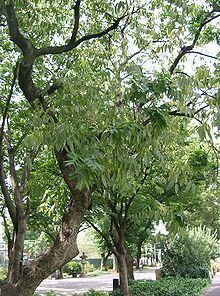Rank Species | Genus Sapindus Higher classification Soapberries | |
 | ||
Similar Soapberries, Sapindaceae, Sapindus trifoliatus, Gleditsia japonica, Acacia concinna | ||
Octonary ingredients of sapindus mukorossi formulations pankaj oudhia s medicinal plant database
Sapindus mukorossi is a species of tree in the Sapindaceae family. The fruit is commonly known as Chinese soapberry or washnut, and like other species in the genus Sapindus, it is called soapberry. It is also a native of Western coastal Maharashtra - Konkan, and Goa in India. Sapindus mukorrossi, known as the ritha or reetha tree in Nepal, is a deciduous tree that is grown in the lower foothills and midhills of the Himalayans, up to altitudes of 4000 feet. It is tolerant to reasonably poor soil, can be planted around farmers’ homes, and one Ritha tree can produce 30–35 kg of fruit per year.
Contents
- Octonary ingredients of sapindus mukorossi formulations pankaj oudhia s medicinal plant database
- Grow nepal started soap nuts sapindus mukorossi gaertn plantation in nepal
- Uses
- Cleanserinsecticide
- Medicinal
- Surfactant
- References
Grow nepal started soap nuts sapindus mukorossi gaertn plantation in nepal
Uses
The value of the tree mostly comes from its fruit, which can be used for many pharmacological and cleansing purposes including, but not limited to, the ones outlined below.
Cleanser/insecticide
The soapnut contains the compound of saponin, which has natural cleansing properties, and therefore the soapnut can be used as a cleanser for hair, skin, and clothing. These saponins are also useful as insecticides, for purposes such as removing head lice off the scalp.
Medicinal
Upadhyay and Singh have suggested that the soapnut can also be used as a natural remedy for many health problems, such as for treating migrane headaches, or for dermatological purposes such as using the seeds to remove skin impurities like pimples or eczema.
Surfactant
Methods of extracting the maximum amount of oil from existing oil reserves has become a scientific focus in a world that has become dependent on fossil fuels. Researchers have found that the Ritha fruit can be used in an enhanced oil recovery technique. More specifically, Chhetri, Watts, Rahman, and Islam (2009) found that extracts from the soapnut can be used as an organic surfactant to increase the mobility of oil from the fields. In addition, researchers have demonstrated the potential for the soapnut to be used as a natural surfactant for washing arsenic from soils that are rich in iron.
